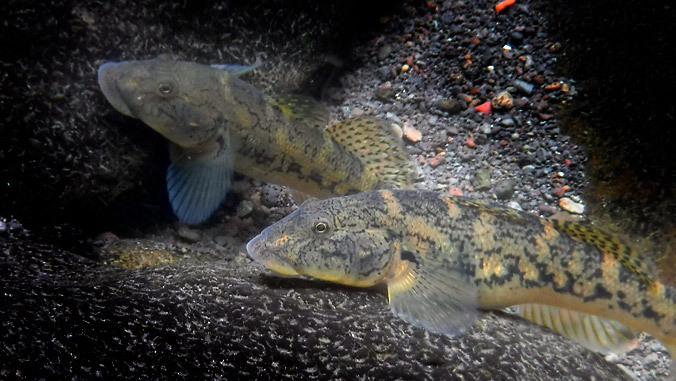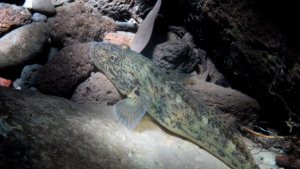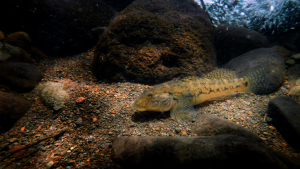
New research out of the University of Hawaiʻi at Mānoa is highlighting the importance of the ma uka (mountain) to ma kai (ocean) approach to the stewardship of Hawaiʻi’s natural and cultural resources.
The research focused on ʻoʻopu nākea, a type of goby fish found only in Hawaiʻi. ʻOʻopu nākea spends the larval part of its life in the ocean before returning to the freshwater streams to complete adulthood. It is also one of five freshwater fishes endemic to Hawaiʻi with fused pelvic fins that act as a suction cup to help climb waterfalls as they migrate upstream.
Unfortunately, like so many endemic species to Hawaiʻi, ʻoʻopu nākea are under threat from climate change and human activity and previous research indicated the species no longer needed to reach the ocean to complete their life cycle.

The UH Mānoa-led team utilized the latest microchemistry methods and found that 100% of ʻoʻopu nākea are still using the ocean as an important part of larval development. The study, “Understanding Amphidromy in Hawaiʻi: ʻOʻopu nākea (Awaous stamineus),” was published in the Journal of Fish Biology, and although the findings were positive, they still highlight the importance of preserving Hawaiʻi’s freshwater streams and bodies of water.
“If our waterways are not maintained, we could see a decrease in native species,” said Yinphan Tsang, co-author of the study and principal investigator of the UH Mānoa College of Tropical Agriculture and Human Resources’ Department of Natural Resources and Environmental Management (NREM) Tsang Stream Lab. “Their larvae wouldn’t be able to travel to the ocean, and the juvenile wouldn’t be able to travel back upstream. There could also be an increase in invasive fish species with the degraded waterways, which compete with our native species for resources.”
The research was a collaboration among UH Mānoa Pacific Cooperative Studies Unit (PCSU), NREM, Oregon State University, U.S. Fish and Wildlife Service and United Kingdom Center for Ecology and Hydrology.
“Our study illustrates one of many connections between terrestrial freshwater ecosystems and the ocean, which highlights how critically important it is to continue Hawaiʻi’s legacy of integrated ecosystem management,” said UH PCSU Director Shaya Honarvar, one of the study collaborators. “This stewardship approach has been at the center of community life for as long as people have inhabited these islands.”
This stewardship approach has been at the center of community life for as long as people have inhabited these islands.
—Shaya Honarvar
The researchers said the results reaffirm the importance of tracking the health of streams and freshwater bodies, and prioritize which waterways and habitats should be restored and protected to ensure the migration of native stream species and ultimately increase their populations.
ʻOʻopu nākea migration paths
The researchers were able to better determine the migratory patterns and life cycle of ʻoʻopu nākea, one of nine freshwater, amphidromous species native to Hawaiʻi. The larvae are born in freshwater and flow down to the ocean and then, as juveniles, migrate back upstream to finish their life cycles.
Due to less rainfall and more frequent drought periods, there is less water in many of Hawaiʻi’s streams with some losing connection to the ocean. Some streams that used to flow year-round may only flow during certain times of the year. Streams diverted to supply freshwater for other purposes, such as agriculture, leave a smaller portion of the original stream to flow downstream.
“Many of Hawaiʻi’s streams and estuaries have been subject to modification as a result of water withdrawals and human-made structures that create barriers to fish passage,” said Gordon Smith, fish and wildlife biologist with the U.S. Fish and Wildlife Service and coordinator of the Hawaii Fish Habitat Partnership. “These habitats are critical for conservation of ʻoʻopu nākea and Hawaiʻi’s other migratory freshwater organisms.”
The Hawaiʻi Commission on Water Resource Management registers existing and new stream diversions across the state and helps regulate streamflow to ensure there is enough water for the community and native animals and plants within a certain habitat.
Analyzing ʻoʻopu nākea life cycles

The researchers were able to analyze the migratory history of ʻoʻopu nākea by using a new microchemistry preparation method to examine the otolith, which is the calcium carbonate structures found in fish heads used for balance.
“Previous research teams analyzed the otoliths by polishing (a common technique where the microscope with the otolith is moved in a rapid circular motion),” said Cody Chacon (Ching), the paper’s lead author and recent NREM graduate student now working as a hydrologist at the Commission on Water Resource Management. “However, these otoliths are microscopic, and the ideal portion to analyze could have been polished away. Therefore, we tried analyzing the otoliths without polishing. As our late ʻoʻopu mentor Dr. Bob Kinzie III once said, ‘Otoliths don’t lie, we just need to listen carefully.’”
Otoliths grow like tree rings, where each day one ring is added. The center represents the larval period of the fish, and the outside rings represent adulthood. Using elemental microchemistry at the Oregon State University’s W.M. Keck Collaboratory for Plasma Spectrometry, the center of the otolith can be analyzed to see the type of environment the larvae were living in. The research team analyzed otoliths from 90 fishes and found all fish lived in a saltwater environment as larvae.
“Cody’s research raises important considerations when evaluating reconstructing migratory history of endemic Hawaiian gobies, ʻoʻopu, that will be fundamental for future research and conservation efforts,” said Jessica Miller, an Oregon State University professor at the Coastal Oregon Marine Experiment Station, and another co-author of the study.
Hannah Clilverd, an ecosystem scientist at the UK Centre for Ecology and Hydrology, and previous postdoc in the Tsang Stream Lab, added, “With this research we are now better equipped to understand the migratory patterns of ʻoʻopu and the streamflow requirements for their survival.”


